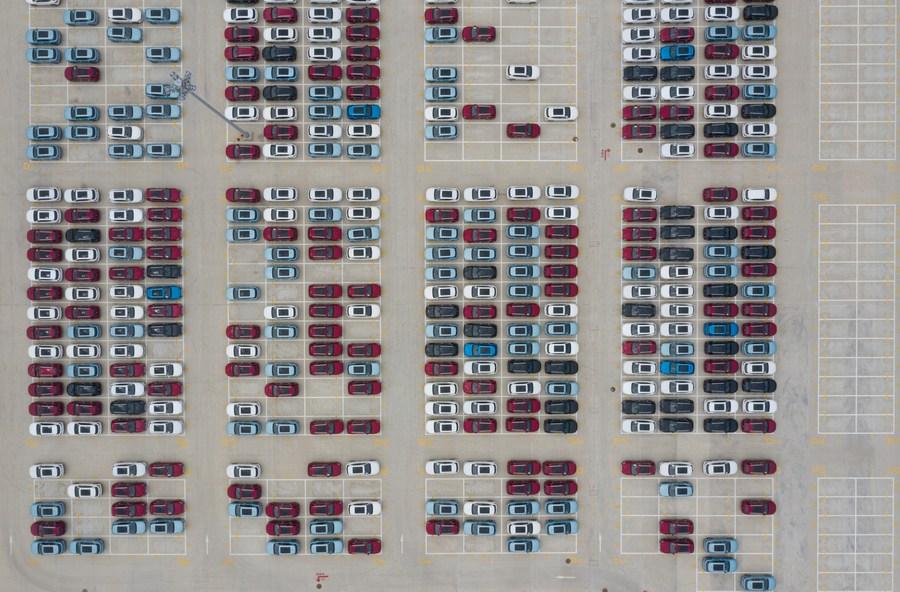
Aerial photo shows cars at the Ningde base of SAIC Motor Corporation Ltd. in Ningde, southeast China's Fujian Province, Sept. 15, 2020. (Xinhua/Song Weiwei)
BEIJING, Aug. 20 (Xinhua) -- Chinese automakers have further accelerated the pace of going abroad since the start of this year, exporting a significantly increasing number of cars to overseas markets, the Xinhua-run Economic Information Daily reported on Friday.
Top exporters in the first half were leading car makers including SAIC Motor Corporation (SAIC Motor, 600104.SH), Chery Holding, Chongqing Changan Automobile Company (000625.SZ), Dongfeng Automobile (600006.SH), Great Wall Motor (601633.SH), Geely Automobile Holdings (Geely Auto, 00175.HK), Beijing Automotive Group, Anhui Jianghuai Automobile Group (JAC Motors, 600418.SH), statistics from the China Association of Automobile Manufacturers (CAAM) showed.
In the first six months, SAIC Motor sold 265,000 vehicles in its overseas markets, showing a year-on-year increase of 112.8 percent, while Chery Holding's auto exports hit a record high of 118,700 units, surging 168.4 percent year on year.
During the same period, Geely Auto's cumulative export volume reached 53,422 vehicles, jumping about 173 percent year on year. With nearly 400 overseas sales and service outlets, the automaker has expanded its presence in about 30 countries and regions in the Eastern Europe, the Middle East, Southeast Asia, Africa, South America and other areas.
From January to July, JAC Motors exported more than 40,000 vehicles, up 144.42 percent year on year. So far, the company has established a marketing network covering more than 130 countries and regions in South America, Africa, the Middle East, Southeast Asia, Southwest Asia and the Eastern Europe, with cumulative export volume standing at over 700,000 vehicles.
The auto export growth in the first half could be attributed to various factors, including the recovery of the international market, stronger competitiveness of Chinese cars, improved overseas layout of automakers and the rising export of new energy vehicle (NEV), said Xu Haidong, deputy chief engineer with CAAM.
The European market was one of the main export destinations of China-made automobiles in the first half. The major reason for the hefty increase in the exports to the market was that in recent years, the green transformation measures in the Europe have promoted the development of local new energy vehicle (NEV) sector, while local electric vehicle industry remains comparatively less competitive, coupled with production suspension in some European countries and regions due to the impact of the COVID-19 pandemic.
China-made cars were also popular in the Middle East and North Africa, with Saudi Arabia, Iran, and Algeria being the principal sales markets.
As China advances cooperation with countries and regions participating in the Belt and Road Initiative (BRI) and Saudi Arabia further implements its Vision 2030 economic diversification plan, China-developed cars boasts huge development potential in Saudi Arabia and even the entire Gulf Region, according to an analyst.
In the Southeast Asian auto market where made-in-Japan autos occupy an overwhelming share, Chinese firms try to win out by growing electric vehicle business.
SAIC Motor plans to boost localized production of electric vehicles through cooperation with the joint venture established in partnership with the Thai conglomerate Charoen Pokphand Group. The Chinese automaker's i-Smart intelligent connected vehicle system, which is well recognized by consumers in Thailand, India, Indonesia and other countries, has been adopted on more than 30 models sold abroad. (Edited by Su Dan with Xinhua Silk Road, sudan@xinhua.org)




 A single purchase
A single purchase









